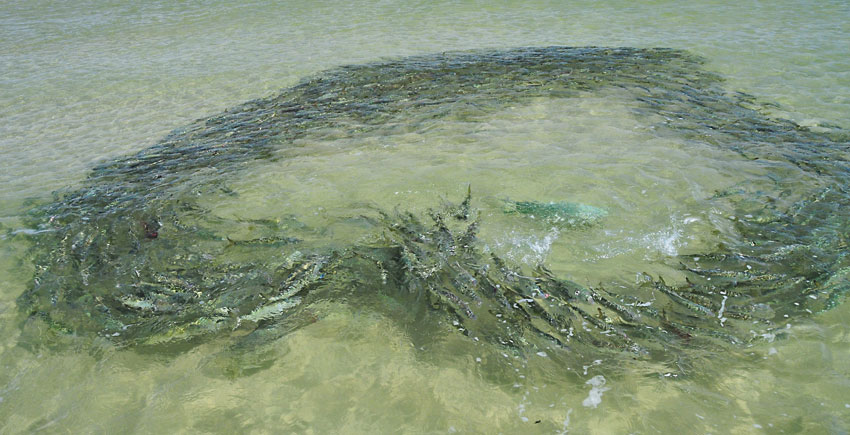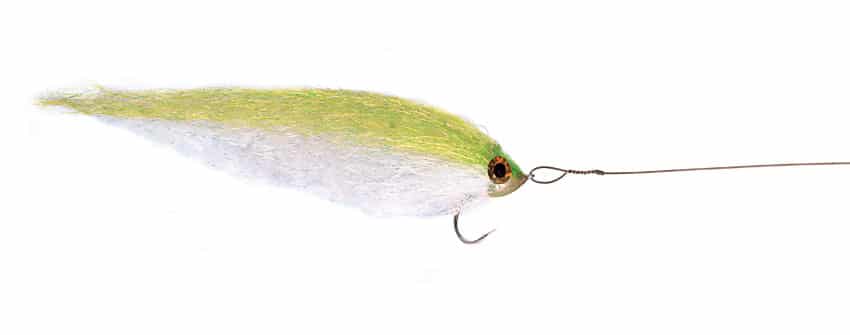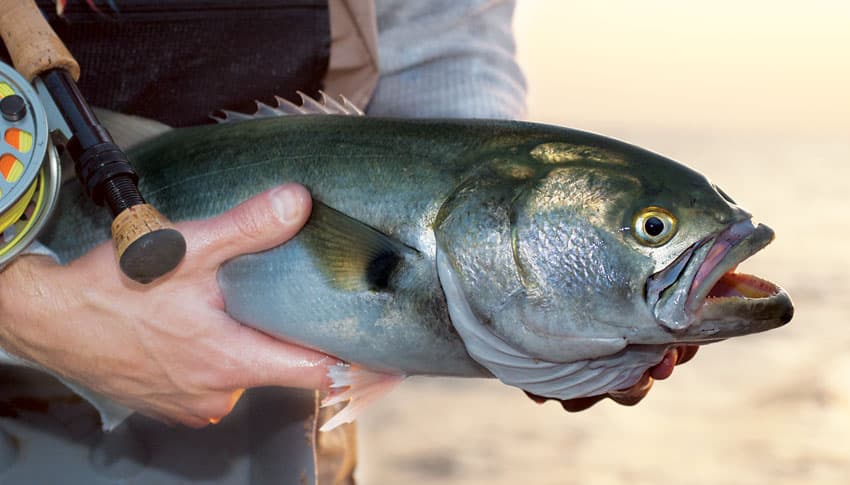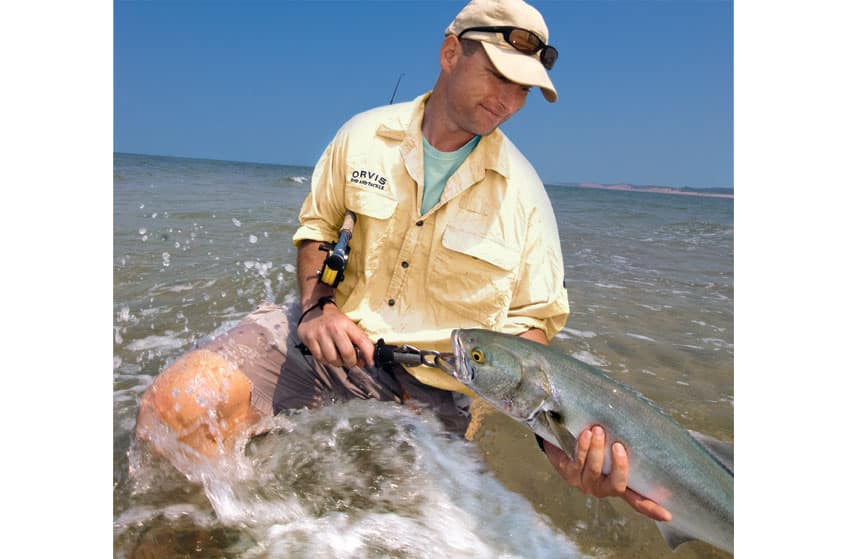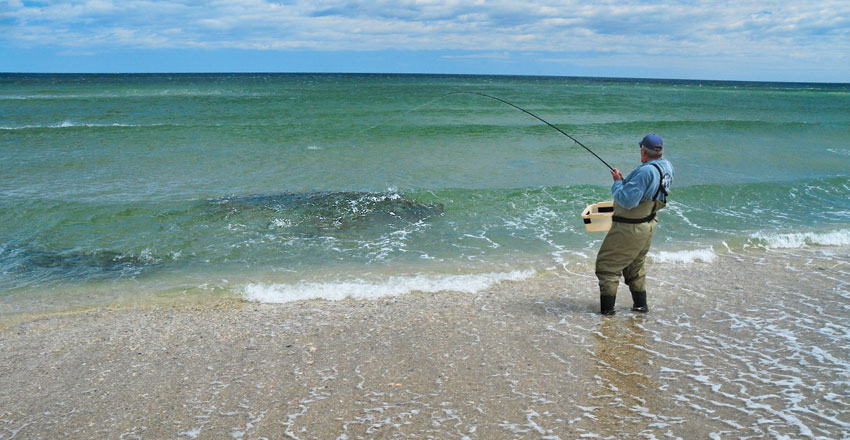
Springtime and fall usually bring the clearest water of the season, and predominant offshore winds keep the water free of sediment that can discolor or cloud the view of the clear white bottom. When mature bunker schools move from Virginia and the Chesapeake Bay, very large bluefish harass them unmercifully, often driving them to the pristine shoreline of New Jersey. This can set up some incredible fishing, as well as some unforgettable visuals. Many of the first schools to arrive show up just off the beach, displaying their presence by rippling the calm surface with indistinct shapes. This is the beginning of what’s to come, as predator sport fish like bluefish and striped bass lurk behind and ready themselves for attack. Fleeing to stay alive, the bunker schools often are pushed to the shoreline as the predators take total control. Within less than an hour, schools that were a mile off the beach are in the wash getting severed dramatically and aggressively by big bluefish. This natural event is unforgettable in the mind of the fly-fisherman.
The Predator
Bluefish are among the meanest and most feared inshore species along the waters of the Northeastern states. Reaching weights of 20 pounds and more, they possess the speed and strength to easily run down their food. With their strong, viselike jaws and sharp conical teeth, bluefish leave no doubt as to how they received the nicknames choppers and slammers.
Blues travel in large schools as they hound schools of baitfish. The attack is quick and all out. Vanguard fish feed directly in the thick schools of bait, while others pick up wounded stragglers too weak to keep up with the baitball. As the melee ensues, bluefish leave a prominent slick on the surface. Many frenzies start with showers of baitfish fleeing skyward, causing white-water displays visible from a distance.
The Prey
Menhaden, commonly called bunker in Jersey, show up along the East Coast going north in spring and south in the fall. They can range from baits as small as an inch when very young to 3 pounds once they’ve reached maturity. Since the predators seem to hone in on size more than any other trait when attacking, size is very important when selecting imitations. Although the lengths of bunker may vary, survival instincts remain constant. They gather fast in tight, quick-moving schools. As continuous assaults thin their numbers, detached members form concentric circles as they seek safety in the center of the pod.
How It Starts
As the beach blitzing begins, bunker schools accelerate, often creating pronounced waves of nervous water moving in one direction. When the bluefish overtake them, the schools get in a circular spin reminiscent of a hurricane, complete with an eye in the middle. School members keep digging toward the center for protection, but time and stress take their toll. The weakened baits are often targeted and grabbed first. Many times, more than one bluefish will attack a single bait, one focusing on the tail and the other on the head. When bunker are big, it’s not uncommon to witness three to four large bluefish attacking a single bait.
Surf Blitz
When bluefish are in on the blitz in big numbers, the baits ultimately end up on the beach. Backs to the wall, scared and disoriented bunker make a last-ditch effort to escape and end up scattered across the dry sand. When this happens, the onslaught has officially begun. It is then that Mother Nature replaces the sweet smell of the salt air with the ominous scent of mauled menhaden. Blitzes can last for hours and be miles long. Blitz beginnings can feature side-by-side bluefish churning the surface like a washing machine, spreading out ranks as they disperse the bait school. This latter progression is very deliberate and less aggressive. The objectives of an assault are to overwhelm the bait at first and then thin them out, scatter them and pick them off one by one.
Fishing Tips
Although chaos may seem to be under way, the event is well orchestrated and calculated. Random casting and retrieving will not bring as many strikes as one might think. The fly-fisherman still must have a plan for success. Casting around the edges of the bait schools yields a more productive hookup ratio than casting into the middle of the school. Search for cruising fish, and try to understand their body language. Aggressive fish make erratic, excited movements as opposed to casually swimming from place to place. Some fish may even look lit up, showing off brighter colors on their flanks. Single out a hot fish, and make your cast. A correct presentation will be affirmed almost immediately. Big bluefish will often charge with a bolt of acceleration and overcome the fly. These fish love a challenging retrieve, one that moves fast and never hesitates, while timid stripping and pause retrieves sometimes frustrate bluefish, causing them to lose interest. Refusals are part of the game too.
Go-to patterns like small Deceivers and tiny Clousers are not the best choices in a big-bait situation. You need a fly that approximates the large, wide shape of mature bunker. Retrieves should mimic a bait frantically trying to get away. Steady movement, with no pauses, produces best.
A lesser cause of refusals, one not often associated with the surf, is lack of angler recognition. The fisherman needs to be totally involved in the presentation proc-ess. Observing the behavior of the fish is key to determining the solution. Once again, understanding the body language of the bluefish is critical, and this should help the angler determine how to retrieve the fly and whether to change the fly or pick another target.
One memorable challenge took place a few years ago as bluefish were holding a school of weakfish close to the sand. As I approached the surf, I picked out a fish and made my cast into the wash. Large and excited, it immediately tracked my offering. My read on its behavior was telling me to increase the retrieve speed or risk losing its interest. As I did, its interest increased but suddenly flagged when the fly flipped on its side. The problem was the fly’s inability to keel under a fast retrieve. Being that this was a sealed-off sandbar area, I could keep my eye on the fish. I quickly changed the fly only to be refused again, as the second fly was no better than the first. A few more refusals, and I switched to a Spread Fleye with a 10/0 Trey Combs hook that tracked beautifully. The big brute ate it on the first couple of strips. The true tracking behavior of the Spread Fleye made all the difference.
Because these baits can reach 3 pounds, flies need to be large. Pull out the biggest stuff you have, like oversize Deceivers, Half & Halfs and poppers. If you have only smaller flies in your box, you can make certain patterns, such as small Deceivers, look much larger by attaching a Banger head in front. The commotion caused by the head creates a larger footprint.
Making Contact
Setting the hook right at the time of the strike is very important. A slow reaction often causes a deep hookup, which isn’t pleasant when it comes to removing a fly from a toothy bluefish. Instead, do your best to set quickly and hard so the hook can dig into the very tough mouth. Strong, sharp barbless hooks with a large gape alway offer the best results. Single-strand stainless wire, knottable wire or heavy mono definately helps prevent bite-offs better than bare leaders. Personally, I keep wire leaders tied with a haywire twist at one end, and when I need one, I attach my fly to the free end with a closing haywire. These leaders are commonly tied in advance and should measure 4 to 6 inches. However, even aggressive bluefish can be picky if wire is present. One tip is to use a fly with a long shank or a short 2-inch wire trace.
Big blues are great fighters. They jump with gills flared and put up long tug-of-war exchanges, with repeated runs into the backing. Anglers need to be active when fighting these brutes. The line is either coming in or going out, never stagnant. While allowing a fish to have its way initially after the hookup, I tighten up right after its first surge in order to gain an advantage. Controlling the bluefish in close is the most important part of the fight. Bluefish may act whipped at this time, but they are notorious for bursts of energy at the end, which often result in broken leaders. When the end of the fight is near, be mindful of a quick energy flare from the fish.
In my many years at the coast, bluefish have provided me countless exciting fishing trips, and they never fail to entertain me. Even seasoned striper fishermen come away from a bluefish blitz with memories that will last forever. Bluefish are perfect fly-rod fish. They’re aggressive, fast and strong. And just when you think you have one finished, it’ll look at you with its big yellow eyes and try to inflict the last bite. Pretty amazing for a fish.
Handling and Releasing
Handling any size bluefish is tough, but slammers have much stronger jaws and bigger teeth than their smaller brothers. If one closes down on your finger or hand, you’ll be sorry, as it’s incredibly difficult to coerce the jaws open. They seem to clamp down stronger with each second, making moderate injury more likely. Proper tools and your undivided attention are imperative when reclaiming what is left of your fly and keeping your hands safe. Needle-nose pliers or a long-handled hook remover help keep your hands farther away from danger. The biggest favor you can do yourself when targeting bluefish is to use flies with barbless hooks. These allow easy removal, without your having to wrestle the fish too much. If you must hold a big fish, slide your fingers inside the gill plate from behind, staying clear of the gills. Be very careful, and work quickly. If you use a de-barbed hook and the proper tools, both bluefish and angler should be fine.
Returning the fish to the water should be done as quickly as possible and with as little handling as possible. Too often I see fishermen place a knee or boot down on a fish as it lies on the sand. This can devastate a blue’s well-being. Do not kick them back or throw them through the air into the water. Even though the species is known for being tough in the salt, they are quite fragile once taken from it. They are to be respected, as all species should.

